 | 330 GT Registry |  |
SPORTS CAR GRAPHIC JANUARY 1967
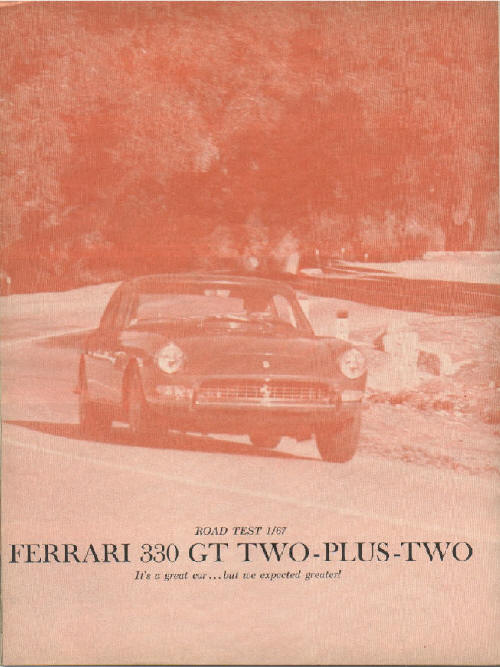
Is a Ferrari a state of mind? Certainly... to some degree. To WHAT degree was what we hoped to determine in our road test of a production Ferrari — the 330/GT Two-plus-two. Over the years road testers around the world have almost traditionally repeated the statement that a Ferrari is designed for the automotive connoisseur. Was this a rationalization indicating that, while it had all the exotic mechanical accoutrements, the sum total wasn’t too exciting? Maybe they were operating on the premise that a $14,000 stone HAD to be a jewel.
| By Jerry Titus | Photos: Gerry Stiles |
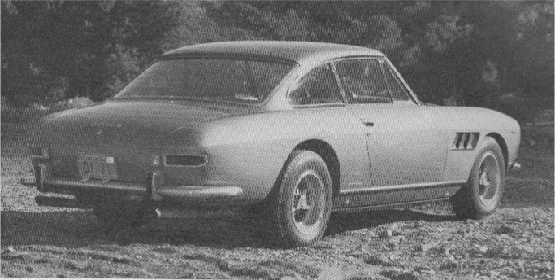 | |
| Tasteful beauty that answers all the functional requirements is achieved in the Pininfarina design. At left, a high-speed sweeper is a place where the Ferrari is really in its element. | |
Ferrari importation in this country was obviously destined for some new action with the news that Reno’s famous Bill Harrah recently took over Western distribution of the marque. Anyone familiar with his classic-car collecting will attest that when he goes into something, he goes into it BIG. We procured a well-used demonstrator from his manager, Larry Hancock, squeezing into its scheduled rounds among celebrities and wealthy folks who are potential buyers. There were some 10,000 miles on the odometer and it’s already a whale of a testimonial that, after being driven this length of time by everyone and his brother, it was still tight and running well. No question in our minds, however, about a Ferrari being able to take this kind of abuse in stride. They are justifiably famous for it.
The 330/GT is one of a quintet of current ‘production’ Ferraris, the others being the 365 California (a convertible sharing the long-wheelbase chassis, but only a handful of which are scheduled to be built), the 330/GT (a short-wheelbase version of the GT body and engine — but with a transaxle and I.R.S. — that we hope to test in the near future), the GTS (a light Spyder, also independently-suspended and short wheel base), and the 275/GTB4 (an even lighter coupe with a 3286-cc engine that develops the same power). Being the least expensive of the line at $14,200, the 330/GT can be called the “economy model.” It is powered by a front-mounted, four-liter V-12 of classic Ferrari design (60-degree V, alloy block and iron liners, hemi heads with chain-driven single cams for each bank, dual ignition, and so on). Directly behind it is a rugged, five-speed transmission — full-synchromesh, with fifth cog an overdrive — and thence, via conventional driveshaft, to a live rear axle. The latter is tied in well with semi-elliptic leaf springs, torque bars and a lateral stabilizing or track bar, plus tubular shocks that also contain an overload-type coil spring to compensate for the load of rear-seat passengers and luggage without making the ride other wise too harsh.
The Farina body is aerodynamically efficient, obviously recognized as Ferrari, and does a good job of understating the car’s considerable size. A 104-inch wheelbase and 3040 pounds is big. The space is well used, however, to provide a very roomy interior with full-sized front buckets and molded-in rear ones, the latter flattering the description as ‘occasional’ usually applied to the rear seats in a two-plus-two. The bodywork, hardware, and interior appointments are all up to and exceeding the standards you’d expect in a luxury GT, so we won’t dwell on them. The side windows are electrically-operated via buttons on the tunnel-mounted console, incidentally. An over-six-footer will find himself with plenty of room behind the wheel, and yet smaller drivers won’t feel buried. The instrument panel is typically Ferrari, with large, legible dials and all switches logically located. In this case they’re of the butterfly type and placed at the lower left edge of the dash, easily reached.
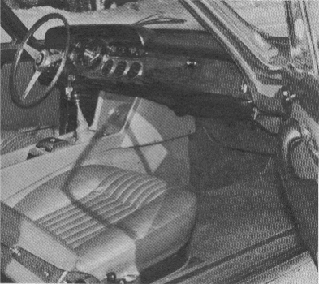 | 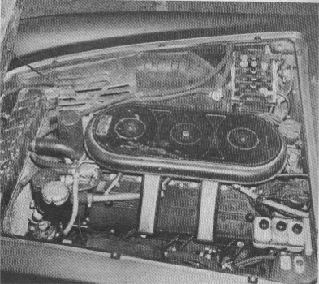 |
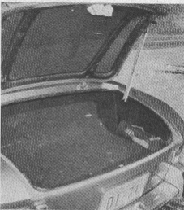 | 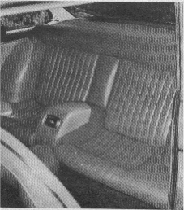 | Interior, upper left, is both rich and functional with full instrumentation, plush seats, some padding, and recessed door handles. The engine compartment, above, appears crowded but air conditioning is a listed accessory. Trunk room, lower left, is adequate and well-shaped. Rear “bucket” seats provide surprising room. |
Outsized and wood-rimmed, the steering wheel is mounted high. Due to the large diameter and a slow ratio, pressure required to turn it is moderate. It is out of context with a sports-type vehicle arid the 45-foot turning circle is larger than that of many Detroit cars. The foot pedals were designed and placed by someone who knew how important both factors were to these controls. It’s a good thing, as clutch pressure is quite high and, even with power assist to the four big discs — through dual master cylinders — braking requires a firmly-placed foot. Each master cylinder has its own vacuum booster beneath the hood, making completely separate systems.
As we stated earlier, the gearbox is a five-speed, fifth being a planetary overdrive with solenoid engagement but actuated conventionally by shifting into a detent like any other gear, and without any free wheeling. The lever is atop the high center tunnel and a bit too far to the rear. You don’t rush the shifts, especially a downshift. The balk-rings either balk or the gears grind. The ratios are nice and very usable, but their choice isn’t critical due to the wide operating range of the engine.
The first couple of days we had the Ferrari were filled with intermittent rain, so our driving was limited to normal commuting and around-town driving. It idled well, but noisily. The brakes and engine stayed dry and defrosters for both the front and rear windows were a blessing. The wipers were kind of funny for a high-speed car. The spring must have been weak in one of them because, at 90 mph, it wiped nothing but air about two inches forward of the windshield. They need those little air-foils to hold them down. The gas mileage for normal use turned out to be in the 16 mpg category; not bad at all. However, it was a pretty unexciting car around town. We started giving the needle to Chic Vandagriff, Ferrari dealer and enthusiast, like asking him when he was going to pick up a Kenworth truck franchise. “You wait until you start really using it !“ was the comment he had.
It dried out the next day and we headed for the mountains and deserts. Ah . . . in Nevada, of course! At 95 mph there’s almost a Jekyll/Hyde change in the car’s character. The little chop in the ride smooths out and it seems to start settling into the road better. Even the noise level diminished. It gets better and better as the speedometer climbs. To get poetic, the damn thing blossoms like a flower. Even the speedometer, which had been reading some 7 miles optimistic at 60 mph, became 2 mph conservative at 90! Above 80 mph, you can drop it into 5th cog and cruise with the engine ticking over a bit above 3000 rpm. Fourth gear extends up into the high 130s, so that’s your passing and grade-climbing gear.
It was no strain at all to get through the standing ¼-mile in 16 seconds fiat, despite an extremely high first gear that just about negated wheelspin. The zero-60 time of 6.8 seconds is uncorrected, but the shift out of first comes right below it and, as we explained earlier, you can’t make it too fast. The shift into fifth gave us a little problem with our acceleration chart, as you’ll see. It occurs at 128 mph and our chart only goes to 120. As far as top speed is concerned, the car reaches 142 miles an hour very quickly, but those last few take quite a while. Ferrari lists the top speed at 153 mph. Without checking speedo accuracy in that range, we reached 151 mph one way and 145 mph on the return trip. The runs were made at night and the lighting was adequate to 135 mph, but edgy after that. A couple of small spot lamps would correct it. The stability at maximum speed is good, even though the road was a little rough and undulating. Above 140 mph there was a disquieting rumble and minor vibration that seemed to originate in the Pirelli Cinturato HS tires that are standard equipment for the car, but no other ill effects. Fast braking from these speeds is easily accomplished and with no after-effects. The brakes’ and the chassis’ reaction to them is really fine.
Cornering is a frustrating experience, especially in the high-speed sweepers. You go in a little hot, figuring it’ll get loose and you’ll correct a bit with wheel and throttle. But it doesn’t. It just settles in mildly and goes around. So you up the next approach by 10 mph and it still does the same thing, with very slight understeer, and absolutely no fuss. Finally, we decided we really didn’t want to find the limit. It was too damned fast already, and to lose it at those speeds would have to be “with drama”. Looking at nothing but sheer cliffs and a few steel guard rails, we forgot it and began to understand the occasional report about some one writing off a Ferrari in a ‘grand manner’. The first reaction is, “What kind of a clod does it take to lose it in a car of that caliber?” Consider this sage advice: If you’re going to try extending a Ferrari to its limit on other than a race course you know cold, you better really know what you’re doing, because you’re going to be peddling terribly fast. In the slower corners, it’s no problem. The understeer is stronger and the slide builds up gradually. Our test mileage, incidentally, included the high-speed and acceleration runs, et al. Twelve to the gallon under these conditions is pretty impressive.
So, okay, Chic, you were right! The Ferrari is a thoroughbred and its reputation, nay, its legend is justified. We’re sure old Enzo will sleep better when he hears this!
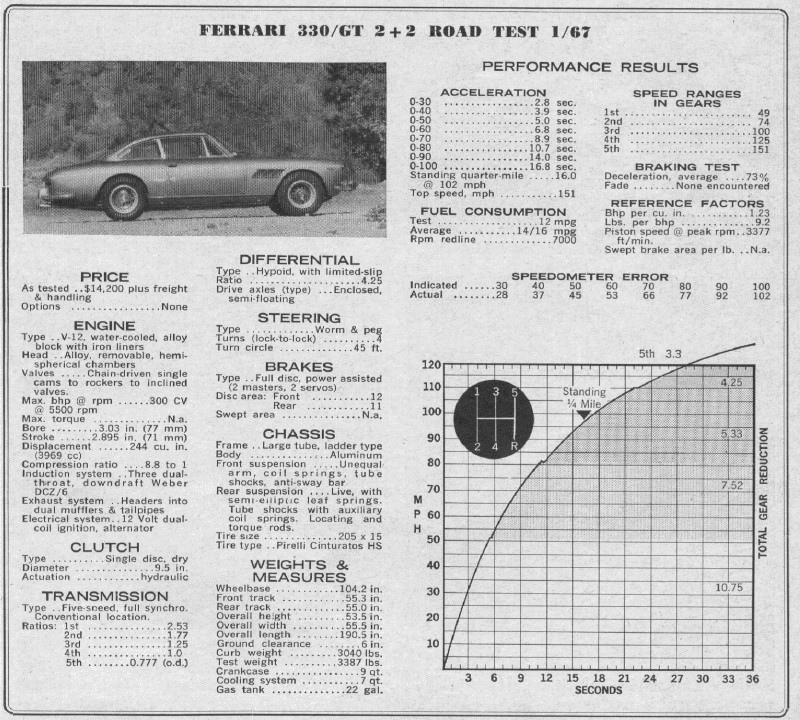
SPORTS CAR GRAPHIC U.S. Copyright 1967